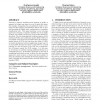Free Online Productivity Tools
i2Speak
i2Symbol
i2OCR
iTex2Img
iWeb2Print
iWeb2Shot
i2Type
iPdf2Split
iPdf2Merge
i2Bopomofo
i2Arabic
i2Style
i2Image
i2PDF
iLatex2Rtf
Sci2ools
CIKM
2008
Springer
2008
Springer
Learning a two-stage SVM/CRF sequence classifier
Learning a sequence classifier means learning to predict a sequence of output tags based on a set of input data items. For example, recognizing that a handwritten word is "cat", based on three images of handwritten letters and on general knowledge of English letter combinations, is a sequence classification task. This paper describes a new two-stage approach to learning a sequence classifier that is (i) highly accurate, (ii) scalable, and (iii) easy to use in data mining applications. The two-stage approach combines support vector machines (SVMs) and conditional random fields (CRFs). It is (i) highly accurate because it benefits from the maximummargin nature of SVMs and also from the ability of CRFs to model correlations between neighboring output tags. It is (ii) scalable because the input to each SVM is a small training set, and the input to the CRF has a small number of features, namely the SVM outputs. It is (iii) easy to use because it combines existing published softwa...
CIKM 2008 | Conditional Random Fields | Information Management | Sequence Classifiers | Two-stage Approach |
| Added | 12 Oct 2010 |
| Updated | 12 Oct 2010 |
| Type | Conference |
| Year | 2008 |
| Where | CIKM |
| Authors | Guilherme Hoefel, Charles Elkan |
Comments (0)

